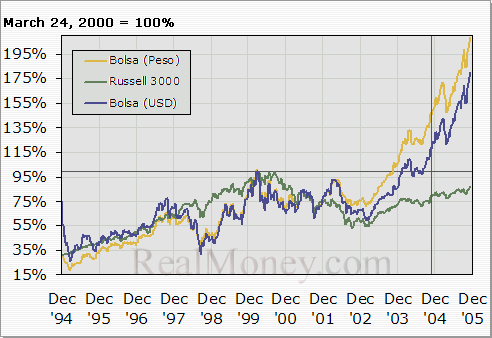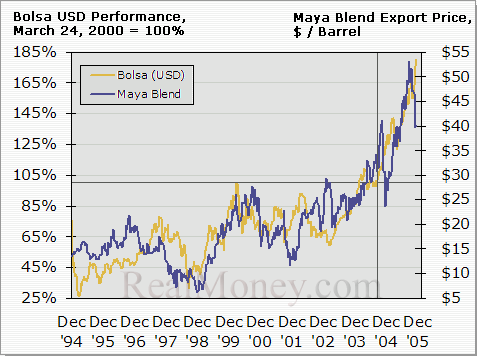 |
 |
 |
 Business News | November 2005 Business News | November 2005  
Mexican Beauties Still Hold Allure
 Howard Simons - RealMoney.com Howard Simons - RealMoney.com

Holidays such as Thanksgiving create markers and memories in our lives. We see people we haven't seen for a while and mark the passage of time accordingly. Reflection can be good for the soul and bad for the digestion.

So it is with the impending end of the calendar year, a time when various financial scribblers summarize what has happened, discuss why it was bound to have happened and look ahead to what they think will happen. I hate these year-end reviews. What can you do with the information provided after the fact that the top-returning stock market for a given year was Mauritius', as was the case in 2002? Go ahead, park your life savings in some guano-encrusted rock pile; see if anyone sympathizes with you.

Mexico Revisited

Let's review the stellar performance of Mexican stocks over the last 16 months. Since I last discussed Mexico in August 2004, the total return of the Bolsa index has been 81.9% in dollar terms; the comparable return for the Russell 3000 has been 19.9%. The degree of outperformance by the Mexican market, marked on the chart below, is rather breathtaking. Moves of this magnitude seldom are sustainable for long periods.

Inflation and the Peso

A visitor from Mars might wonder why inflation is so accepted here on Earth. As I've observed on more than one occasion, the current consumer price index reading of 198.9 means the dollar's purchasing power has been halved since the index's 1982-84 base, and this is in a period we still regard as disinflationary (emphasis added to convey righteous indignation). The problem has been worse, much worse, south of the Rio Grande. Since January 1973, the peso has lost 99.9765% of its purchasing power.

If we plot the relative purchasing power of the dollar and peso on logarithmic scales, the peso axis requires three more cycles to depict. But an American looking at this graph should sit down and shut up, not giggle: The deterioration of the dollar is accelerating while the deterioration of the peso has leveled off.

Mexican Stocks Leave U.S. In Dust  Source: Bloomberg 
Nothing bad emerges from lower inflation, which is not to say we should hope for the deflation extant in Japan in recent years and feared here in 2003. All else held equal, lower inflation allows for businesses to increase their planning horizons and for long-term interest rates to remain under control.

Race To The Bottom  Source: Bloomberg 
In the case of the peso, lower inflation has allowed the yields on 91-day Cetes, the equivalent of Treasury bills, to fall even as short-term rates in the U.S. have increased at a measured pace.

Peso Moves Higher Even As Cetes Rates Fall  Source: Bloomberg 
Those who confuse wider interest rate gaps with a stronger currency should take heed. The peso has increased 7.38% against the dollar since August 2004. While some Mexican manufacturers, particularly those located in the maquiladora region near the U.S. border, may lament the stronger peso, it is an unalloyed boon to Pedro Juan (the Mexican counterpart to Joe Six-Pack). Mexico's competition as an exporter to the U.S. lies across the Pacific in China, and just as there is no yuan level that would make American labor cost-competitive with Chinese labor, there is no yuan level that would allow Mexico to win a price war with China, either. Competitive devaluation never works.

Crude Oil Dependency

Now here's the tough question: Has the stellar performance of the Mexican markets over the past 15 months been the result of anything the Mexicans have done, or is it solely the result of the ongoing rally in crude oil? It's all well and good to be the recipient of good fortune and not to squander it, but at the very least, never confuse skill with luck. For whatever it's worth, I would rather be lucky than good -- the former has unlimited upside, and the latter really doesn't.

The Bolsa and the export price of Mexico's Maya Blend crude oil have been linked for some time. In recent months, stocks have outperformed crude oil and have appeared to do so with lower volatility. Maya Blend has shed 25% of its price since the Katrina-period peak, while the Bolsa has gained 14.9% in dollar terms.

There is no real and comparable precedent to indicate what would happen to the Bolsa if crude oil prices turned lower over a protracted period. I believe that crude oil is still in a long-term bull market, however, the Clint Eastwood test still applies in situations such as these: How lucky do you feel?

Can Oil Keep Going Higher?  Source: Bloomberg 
Cementing the Bond

American investors associate trading oil-related stocks with oil prices. But Pemex, the Mexican state oil company, is just that, a government monopoly. It would be like us trying to invest in the U.S. Postal Service. So who have been the gainers in Mexico in 2005?

The top performer has been Corporacion Geo, a real estate developer in Mexico and Chile that is up more than 60%. It has been followed by America Movil (AMX:NYSE ADR), a wireless communications provider that's up 57%. Then we have Urbi Desarrollos, another real estate developer; America Telecom; Wal-Mart de Mexico; Cemex (CX:NYSE ADR), the big cement manufacturer; Banorte, a bank; and Grupo Cementos Chihuahua, another cement manufacturer.

Forgive me for thinking the Mexican economy is driven by new homeowners making cell-phone calls to buy cement at Wal-Mart on credit.

Much of Cemex's business is global now; it's one of the leading suppliers for China's road-building and construction programs. The telecom market in Mexico is vast, and Mexicans are in no less need of banking services and retail outlets than we are. On a macroeconomic scale, the country is sensitive to oil prices for government revenues and all that flows therefrom, but you can invest in Mexico without buying into the oil industry.

Entry into the Mexican market through closed-end funds such as The Mexico Fund (MXF:NYSE) or exchange-traded funds such as the iShares MSCI Mexico Fund (EWW:Amex) is simple and straightforward. Just remember, as I'm sure you did at the Thanksgiving table, moderation is a virtue. You don't want to be in the position of being the fellow who put it all on Mauritius in January 2003. A 2%-3% portfolio allocation to Mexico is good enough.

Please note that due to factors including low market capitalization and/or insufficient public float, we consider iShares MSCI Mexico Fund to be a small-cap stock. You should be aware that such stocks are subject to more risk than stocks of larger companies, including greater volatility, lower liquidity and less publicly available information, and that postings such as this one can have an effect on their stock prices.

Howard L. Simons is president of Simons Research, a strategist for Bianco Research, a trading consultant and the author of The Dynamic Option Selection System. Under no circumstances does the information in this column represent a recommendation to buy or sell securities. | 
 | |
 |



